Electric aircraft are growing bigger and flying further, evidenced by two recent developments in Europe and the US. European start-up Maeve Aerospace has unveiled plans for an 84-seat hybrid-electric aircraft, the M80, while US hybrid-electric manufacturer Ampaire has claimed a new endurance record, operating a demonstrator aircraft for 12 hours in a continuous circuit test flight in California. Maeve’s twin-engine M80 is the third design announced since 2022, when it proposed an eight-motor, 44-seat battery-electric aircraft, which it replaced this year with a revised four-motor version, the Maeve 01. The latest design will have two hybrid-electric engines and 10 battery packs, be compatible with sustainable aviation fuels and is aiming for entry into service by 2031. Ampaire is working towards 2024 US certification of a hybrid-electric propulsion system to retrofit into commuter planes.
Maeve Aerospace, jointly-based in the Netherlands and Germany, has designed the new M80 to carry up to 84 passengers in a single-class layout, or 76 in a two-class cabin, on routes of up to 800 nautical miles (1,482 kilometres). Its hybrid-electric powertrain will provide electric-boosted take-off and climb and the aircraft will be able to fly at up 400 knots (740 kph) at a maximum altitude of 35,000 feet.
Funded by private investors, the Dutch government and the European Investment Council, the M80 is being developed as a successor to fossil-fuelled regional jets and older turboprop airliners such as the De Havilland Dash 8 family. From its initial base in Delft, the Netherlands, the company is adding a second facility at Oberpfaffenhofen Airport near Munich to advance the M80 programme.
Maeve says the aircraft will be certified to operate with 100% hydrogen-based power-to-liquid sustainable aviation fuel and other SAF types, reducing CO2 emissions by more than 95% below similar-size existing aircraft types. It claims the M80’s trip costs will be 25% lower than those of equivalent-sized regional jets, while seat-mile costs will be more than 20% below those of current-model turboprops. The plane’s new airframe design and high-performance propulsion are projected to use 40% less fuel than regional jets when flying at cruise level.
“To my knowledge, there are currently no alternatives in development that are equally sustainable, cost-effective and match the operational needs of airlines and airports,” said Martin Nüsseler, Maeve’s CTO. “If there are, I would applaud them, because we need more of these realistic solutions to become sustainable.”
In Camarillo, California, hybrid-electric developer Ampaire performed what it claims to be a record 12-hour endurance flight, covering 1,375 miles (2,212 kilometres) in a continuous circuit with a twin-engine Cessna 337 Electric EEL, which landed with an estimated two hours of fuel and battery reserves remaining.
The aircraft has been used as a testbed for high-powered electronics, inverters, motors and other systems, and a platform for development of the AMP-H570 AMP Drive hybrid propulsion system now installed in the company’s Eco Caravan, a retrofitted Cessna 208B commuter plane, for which it is targeting 2024 supplemental type certification from the US Federal Aviation Administration.
Los Angeles-based Ampaire says the new powertrain has delivered 50%-70% reductions in fuel consumption and emissions compared to the conventional Pratt & Whitney PT6 turboprop engines installed in Cessna Caravans.
“Through this groundbreaking mission, Ampaire has shattered the conventional boundaries of electrified flight,” said Kevin Noertker, Ampaire’s CEO. “Our unique hybrid electric solutions deliver unparalleled operating economics and unlock endurance and operational flexibility critical to our customers’ needs.”
The company has orders and options from airlines and lessors for Cessna Caravan propulsion conversion kits and is progressively targeting retrofits for larger aircraft, beginning with the De Havilland Twin Otter.
Image: Maeve Aerospace’s planned M80 hybrid-electric aircraft















More News & Features
ZeroAvia intensifies UK activity, as it progresses certification of zero emission powertrains
KLM and Transavia partner with Elysian to develop battery-electric regional aircraft and ecosystems
Heart Aerospace in surprise HQ move from Sweden to Los Angeles, citing bigger US opportunities
Airbus resets hydrogen plans, flags new aircraft and announces multiple sustainability initiatives
Four zero-emission aircraft and powertrains prepare for test flights in Australia and New Zealand
Heart Aerospace unveils full-scale 30-seat hybrid-electric aircraft demonstrator